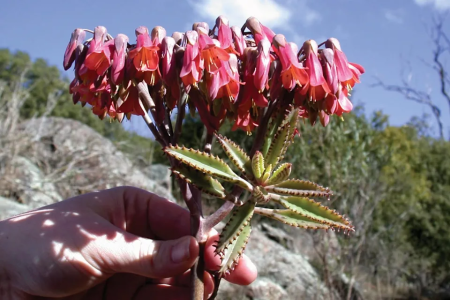Is This Common Backyard Plant Putting Your Family at Risk? Shocking Poisoning Prompts Urgent Warning for Aussies
By
Gian T
- Replies 1
If you’ve ever admired the striking red flowers of a succulent growing along the roadside or in your neighbour’s garden, you might want to take a closer look—because that 'pretty' plant could be hiding a deadly secret. The plant in question is the notorious mother-of-millions, and it’s causing serious concern across Australia after a recent poisoning incident prompted an urgent warning from authorities.
Mother-of-millions (Bryophyllum spp.), native to Madagascar, is a succulent that’s become a common sight in Australian gardens, roadsides, and even rubbish tips. With its tall stems and clusters of vibrant red or pink flowers that bloom in winter, it’s easy to see why gardeners were once drawn to its ornamental appeal. But don’t be fooled by its looks—this plant is a wolf in sheep’s clothing.
The real danger of mother-of-millions lies in its extreme toxicity. All parts of the plant contain potent toxins called bufadienolides, which can cause severe poisoning in livestock, pets, wildlife, and even humans. According to NSW’s Local Land Services (LLS), cattle are especially at risk, as they may turn to the plant when other food sources are scarce during dry or frosty periods.
A recent case near Gravesend in north-west NSW saw livestock poisoned after ingesting the plant, with symptoms including diarrhoea, drooling, loss of appetite, and, tragically, sudden death from heart failure. The risk is highest in winter, when the plant is flowering and alternative feed is limited.
While it’s less common for humans or pets to eat enough of the plant to be poisoned, the risk is still there, especially for curious dogs or young children who might nibble on the leaves.
How Does It Spread?
Mother-of-millions is a master of survival. Each plant produces hundreds of tiny plantlets along its leaf edges, which can easily take root wherever they land. The plant spreads rapidly through dumped garden waste, water runoff, and even flood events. It thrives in sandy soils and disturbed areas like roadsides, fence lines, and rubbish dumps.
Because it’s still legally sold and traded in many places, many Australians don’t realise they’re introducing a weed into their gardens. In fact, three-quarters of all listed weeds in Australia started out as ornamental plants!
Where Is It a Problem?
Mother-of-millions is a declared weed in Queensland and is also a significant problem in NSW, the Northern Territory, Victoria, and parts of southern and Western Australia. It’s so invasive that it was nominated as a Weed of National Significance—a title reserved for species with the potential to cause major environmental and economic damage.
What Should You Do If You Spot It?
Authorities are urging all Aussies, especially those living in rural or semi-rural areas, to learn how to identify mother-of-millions and regularly inspect their properties. If you find it, don’t just toss it in the compost or green waste bin—bag it up securely and put it in your regular rubbish bin to prevent it from spreading.
Never share or swap this plant with friends or neighbours, and avoid dumping garden waste in bushland or waterways. If you’re unsure about a plant in your garden, resources like NSW WeedWise can help you identify and report problem species.
A Call for Stronger Action
Experts like Imogen Ebsworth from the Invasive Species Council are calling for mother-of-millions to be removed from sale across the country, describing the current situation as a 'regulatory failure'. With so many weeds starting out as garden plants, it’s clear that more needs to be done to protect our environment, our pets, and our livelihoods.
How to Protect Your Family, Pets, and Livestock
Have You Had a Run-In With This Plant?
We’d love to hear from you! Have you spotted mother-of-millions in your area? Have you had to deal with it in your garden, or do you have tips for safe removal? Share your stories and advice in the comments below—your experience could help keep others safe.

Let’s work together to keep our backyards, pets, and communities safe from this silent invader. Stay vigilant, and don’t let this 'pretty' plant fool you!
Read more: Dog owners battle hidden poison threat across country
Mother-of-millions (Bryophyllum spp.), native to Madagascar, is a succulent that’s become a common sight in Australian gardens, roadsides, and even rubbish tips. With its tall stems and clusters of vibrant red or pink flowers that bloom in winter, it’s easy to see why gardeners were once drawn to its ornamental appeal. But don’t be fooled by its looks—this plant is a wolf in sheep’s clothing.
The real danger of mother-of-millions lies in its extreme toxicity. All parts of the plant contain potent toxins called bufadienolides, which can cause severe poisoning in livestock, pets, wildlife, and even humans. According to NSW’s Local Land Services (LLS), cattle are especially at risk, as they may turn to the plant when other food sources are scarce during dry or frosty periods.
A recent case near Gravesend in north-west NSW saw livestock poisoned after ingesting the plant, with symptoms including diarrhoea, drooling, loss of appetite, and, tragically, sudden death from heart failure. The risk is highest in winter, when the plant is flowering and alternative feed is limited.
While it’s less common for humans or pets to eat enough of the plant to be poisoned, the risk is still there, especially for curious dogs or young children who might nibble on the leaves.
How Does It Spread?
Mother-of-millions is a master of survival. Each plant produces hundreds of tiny plantlets along its leaf edges, which can easily take root wherever they land. The plant spreads rapidly through dumped garden waste, water runoff, and even flood events. It thrives in sandy soils and disturbed areas like roadsides, fence lines, and rubbish dumps.
Because it’s still legally sold and traded in many places, many Australians don’t realise they’re introducing a weed into their gardens. In fact, three-quarters of all listed weeds in Australia started out as ornamental plants!
Where Is It a Problem?
Mother-of-millions is a declared weed in Queensland and is also a significant problem in NSW, the Northern Territory, Victoria, and parts of southern and Western Australia. It’s so invasive that it was nominated as a Weed of National Significance—a title reserved for species with the potential to cause major environmental and economic damage.
What Should You Do If You Spot It?
Authorities are urging all Aussies, especially those living in rural or semi-rural areas, to learn how to identify mother-of-millions and regularly inspect their properties. If you find it, don’t just toss it in the compost or green waste bin—bag it up securely and put it in your regular rubbish bin to prevent it from spreading.
Never share or swap this plant with friends or neighbours, and avoid dumping garden waste in bushland or waterways. If you’re unsure about a plant in your garden, resources like NSW WeedWise can help you identify and report problem species.
A Call for Stronger Action
Experts like Imogen Ebsworth from the Invasive Species Council are calling for mother-of-millions to be removed from sale across the country, describing the current situation as a 'regulatory failure'. With so many weeds starting out as garden plants, it’s clear that more needs to be done to protect our environment, our pets, and our livelihoods.
How to Protect Your Family, Pets, and Livestock
- Inspect your garden regularly for unfamiliar succulents, especially those with tall stems and clusters of small red or pink flowers.
- Educate your family and neighbours about the risks of mother-of-millions.
- Keep pets and livestock away from areas where the plant is growing.
- Dispose of the plant responsibly—bag it and bin it, don’t compost or dump it.
- Report sightings to your local council or weed authority.
Have You Had a Run-In With This Plant?
We’d love to hear from you! Have you spotted mother-of-millions in your area? Have you had to deal with it in your garden, or do you have tips for safe removal? Share your stories and advice in the comments below—your experience could help keep others safe.
Key Takeaways
- Aussies are being warned about the risks of the mother-of-millions plant, a toxic invasive weed often found on roadsides and in backyards, which can cause sudden death in livestock, especially cattle.
- The plant is extremely poisonous to livestock, pets and humans, with livestock most at risk during winter and dry periods when food is scarce; ingestion can result in diarrhoea, drooling, loss of appetite, heart failure and rapid death.
- Experts are concerned that mother-of-millions is still legally sold and traded as an ornamental succulent, despite its potential to spread rapidly, take over natural areas and cause significant environmental and economic harm.
- Aussies are urged to regularly check their properties for this weed, avoid sharing or dumping garden cuttings, and dispose of mother-of-millions responsibly by securely bagging and binning it rather than composting, to prevent its further spread.
Read more: Dog owners battle hidden poison threat across country








